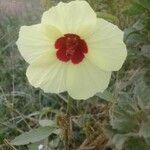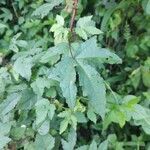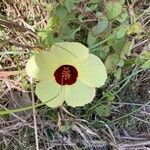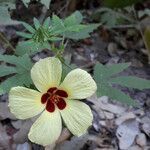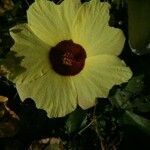A spiny vine or shrub. It grows each year from seed. It is 0.5-2 m high but often lies over. The leaf stalk is 2-7 cm long. It is densely hairy. The leaves are alternate and deeply lobed. There are 3-5 lobes. They are somewhat hairy and with toothed edges. The leaves are 5-10 cm long by 5-11 cm wide. The lobes are sword shaped and 3-7 cm long by 1.5-3 cm wide. The flowers occur singly in the axils of leaves. The flowers are large and yellowish or whitish and tinged with red. The fruit is a capsule which is oval or round and 1.2 cm across. The seeds are kidney shaped with very fine white hairs.
Leaf-lamina up to 10 × 10 cm., broadly ovate to suborbicular in outline, sparsely hispid on both surfaces and aculeate on the nerves beneath, palmately 3–5-lobed (sometimes only shallowly) to palmatipartite; segments elliptic, somewhat constricted towards the base, rather coarsely toothed; petiole up to 11 cm. long, hairy like the stems; stipules up to 15 × 10 mm., broad, auriculate, ± amplexicaul.
Prostrate annual herb, climber or scrambler, with small recurved prickles on stems, petioles and peduncles. Bracts of epicalyx clearly forked. Stipules broad, auriculate and amplexicaul. Flowers yellow with purple centre.
Flowers up to 10 cm. in diam., yellow with purple centre, solitary, axillary; peduncle up to 6–7 cm. long, hispid and aculeate, articulated 3–7 mm. below the apex and often more densely hispid above the articulation.
Calyx 10-veined, becoming scarious; lobes up to 25 × 10 mm., ovate-lanceolate, usually somewhat rigid with long sharp apices, setose and aculeate on the median and marginal nerves.
Annual herb, prostrate or climbing or scrambling up to 3 m.; stems hispid and/or pubescent and sparsely to rather densely aculeate.
Epicalyx of 8–9 bracts; bracts 10–15 mm. long, forked with the inner branch linear and inflexed and the outer branch spathulate.
Seeds 3–3·5 × 2·5 mm., subreniform, with a few minute white appressed-stellate hairs.
Style branching 5 mm. above the apex of the staminal tube; branches 2–2·5 mm. long.
Staminal tube up to 15 mm. long; free parts of filaments 1·5–2·5 mm. long.
Capsule 15 × 12 mm., globose-ovoid, densely appressed-pilose, apex acute.
Petals up to 5 × 3·5 cm., obovate, glabrous or nearly so.
Stems with spreading hairs and recurved prickles
Herbaceous, trailing or climbing
Flowers yellow with red centre.
